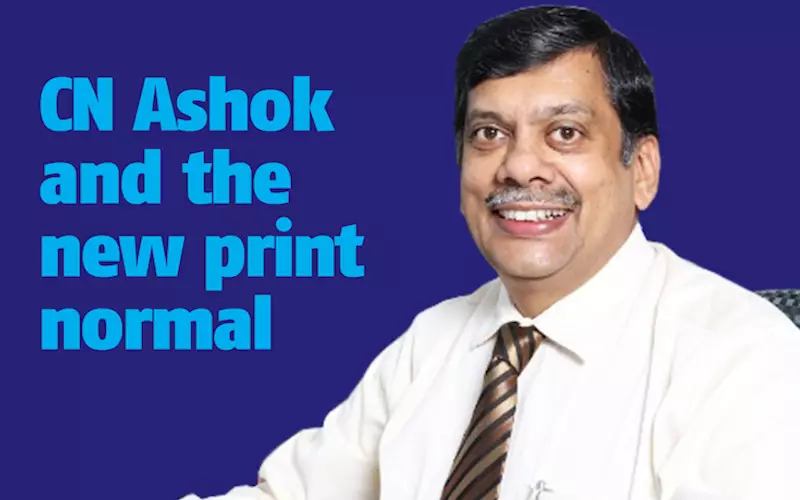CN Ashok and the new print normal - The Noel D'Cunha Sunday Column
CN Ashok, managing director at Autoprint, says, print is unique. “We should not look at how the other industries operate nor dwell too much on the pain points of those industries.”
14 Jun 2020 | By Noel D'Cunha
In this Sunday Column, Ashok of Autoprint feels that our industry’s pain points are internal and only a few are external as compared to other industries. “This can be turned into our advantage.”
Covid-19 crisis has pummelled the economy of nation’s world over, India is no exception. The lockdown is slowly being lifted and, how we return to business will become important.
I think we can vary our costing and improve our profitability by working on wastage reduction, enhancing production by process and manpower capability. We can improve our margins every day by introducing as well as strengthening the process in the organisations. It is a must. If done well, it can reduce many pain points.
Consistency in print quality
There are six simple steps for every mid-sized and micro unit:
- Step 1: Make the entire team believe that quality is produced and not checked
- Step 2: Appoint a data analyst at mid-level
- Step 3: Collect data and analyse
- Step 4: Vis-à-vis analysis, strengthen the process in all departments
- Step 5: Introduce variable pay on reduction of wastage
- Step 6: Celebrate improvement in quality
Waste is often overlooked
We have produced and sold 45 machines of carton inspection. These machines inspect close to 500-cr cartons annually to the pharma industry in the country. The machine has a report-generating feature – process-wise and shift-wise. These reports can be analysed and action taken.
We expect a 2% wastage reduction due to process improvement in the printing press using data generated from our inspection machine. 2% translates to 10-crore cartons annually. This is 5-lakh kgs of board saved.
I believe that measurement on a day to day basis and process strengthening in carton manufacture will go a long way in improving the environment.
Customer and price elasticities
There is a simple costing method called marginal costing. For example:
Sales
XXX
-
Variable
(XXX)
=
Contribution
XXX
-
Fixed
(XXX)
=
Net profit
XXX
Variable cost is always measured as a percentage (%) to turnover and fixed cost will be an absolute figure (must not be measured as a % to sales). This is the key.
Being a finance man, I believe if the above is adopted in the organisation, the entire problem which has been stated above can be solved. The major issue with organisations is that most do not classify the expenses as variable and fixed nor measure and control the same month-on-month. If this is done, we can price differently. And so, you can have a specific pricing for each customer, and even delegate the power of price-fixing to lower-level employees in the team.
Spoilage rate – 10% or 5% of sales
I cannot comment on the wastage percentage. All I can say is that it is high and effective improvement measures are not in place driven from the top barring a few benchmarked units in the country. This is an area that needs to be a focus in the post-Covid era.
An avoidable commonplace mistake
Unmindful extension of credit to customers without enforcing policies.
This entails many discomforts, putting pressure on cash flow etc. Strict discipline in delivering quality outputs at the right time can help improve payment terms from customers.
To win an order in stiff competition does not mean extending unreasonable credits. It’s better to lose an order to competition than do something which will go against your liquidity.
Human resource
If management skill on HR and tools like Kaizen (continuous improvement) and suggestion schemes are implemented top-down and translated into habits, the industry will attract top talent easily.
This will also require high discipline in review culture in the management, rather than review “on the go, minute by minute.” The minute by minute review irritates the empowered employee and he leaves the job. This is a work culture that requires change at the top.
Software and workforce
Discipline and only discipline. The computer and software can only provide an output based on quality input. Unfortunately, the discipline in timely input with quality is poor.
If this is corrected with periodic data analysis and house-keeping then the software investment will be justified with enhanced efficiency. Automation through software is a must. And so, the periodic capital expenditure must be earmarked by the top management in the Capex.
Training programmes to inculcate different value systems. One training programme that added value and made a difference?
I believe training is a continuous process. We need fresh inputs periodically from the changing environment. I seek the help of consultants, mentors and professional entrepreneurial groups as my sounding board. Post-Covid, the help of such forums are extremely important to reduce risks. I am not a great fan of attending one focused training program for two or three days.
At the end of the day, as a leader, conviction should drive you to execute your learning from training.
Print vis-a-vis technology
I strongly believe that AI (Artificial Intelligence) and deep machine learning will change all the industries. This will also definitely happen in the print industry. I feel all the people in senior management should be watchful of the influence on AI in the days to come. The direction for 2030 through AI is yet not clear.
A tip for the rest of 2020 ...
Drop margins, improve liquidity and stay safe.











 See All
See All